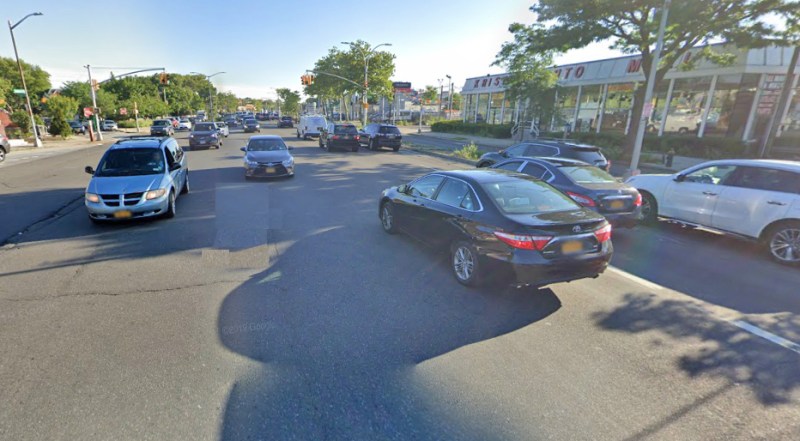DATA: Safe Streets Are an Equity Issue — And the City is Failing the Most Vulnerable

Thousands of people of all colors enthusiastically joined Black Lives Matter marches, but equity remains elusive for a simple reason: politicians are slow to re-allocate scarce resources from people of privilege to those without.
In terms of traffic safety, Mayor de Blasio has shown — both in budget cuts and, as you’ll see, in the allocation of resources — that even when he has no electoral risk, he does not have the mettle to end the “Tale of Two Cities” divide that he himself once highlighted.

The numbers give us a stark reminder of the inequalities communities of color suffer every day: If you are raising a family in a community where more than 75 percent of the population is Black or brown, the risk that your children will be injured in a car crash is twice as high as in other communities. (The city itself is 68 percent non-White):
So let’s break that down: Despite Mayor de Blasio’s Vision Zero program, injuries from traffic crashes in 2018 and 2019 were 1 percent higher than in 2016 and 2017. But in communities of color, the number of crash-caused injuries are soaring by double digit percentages (all stats from Crashmapper, a map based on city data, crunched by CHEKPEDS and BetaNYC).
For instance:
- In neighborhoods that are 90 percent non-White, injuries were up 14.4 percent in the 2018-19 period compared to the 2016-17 period.
- In neighborhoods that are 75-89 percent non-White, injuries were up 14.1 percent.
- In neighborhoods that are more than 50 percent White, however, injuries were up just 2 percent.
Locally, here’s how that breaks down:
- In Queens Community Board 4 (Corona), injuries are up 35 percent in the 2018-19 period compared to the 2016-17 period. The neighborhood is 94.3 percent non-White.
- In Bronx Community Board 4 (Highbridge), injuries from crashes are up 31 percent. The neighborhood is 98.4 percent non-White.
- In Bronx Community Board 1 (Mott Haven), injuries are up 27 percent. The neighborhood is 98 percent non-White.
- In Bronx Community Board 9 (Castle Hill), injuries are up 25 percent. The neighborhood is 97.1 percent non-White.
Meanwhile, in the whitest parts of town:
- In Staten Island’s southernmost district, injuries are up just 1 percent in the 2018-19 period, compared to the 2016-17 period. The neighborhood is 84 percent White.
- On Manhattan’s Upper East Side, injuries are up 1 percent. The neighborhood is 76 percent White.
- In Manhattan’s Greenwich Village and Soho, injuries are down 5 percent. The neighborhood is 73 percent White.
- On Manhattan’s Upper West Side, injuries are down 12 percent. The neighborhood is 67 percent White.
What’s driving the disparate results? One would think that roads built by engineers are standardized. But they are not — and the numbers show that when the city makes a safety improvement on a roadway, injuries go down: The whitest neighborhoods in town — those with more than 51 percent Whites — had 16 percent more safety redesigns or improvements than neighborhoods that are 51 to 74 percent non-White. But the higher number of interventions led to just a 2-percent increase in crashes in the majority White neighborhoods, but a 9-percent increase in crashes in those 51- to 74-percent non-White areas (see chart below).
But street safety projects — like all public initiatives — are the result of political pressure being put on the various agencies to do their job. And White neighborhoods have more power in de Blasio’s Vision Zero:
- Majority White neighborhoods got 28.8 percent of the safety interventions since the start of 2014, even though those neighborhoods comprise 22.5 percent of the injuries between 2016 and 2019.
- Neighborhoods with more than 90 percent non-White population got 24.9 percent of the safety interventions, despite suffering 29 percent of the injuries.
The city needs to review its policies and remove obstacles to a rapid and equitable deployment of life saving services and features.
In addition, since the Bloomberg era, the city does not spend any transportation money on sidewalk maintenance to serve pedestrians — infrastructure spending that would benefit the 68 percent of the city that is non-White. And basic street safety features, like a sidewalk extension, require deep-pocketed private partners. These institutional choices by the city have profound effects on the 3.8 million New Yorkers who live in neighborhoods with populations comprised of more than 75 percent people of color.
Why are local elected officials not clamoring for street safety? What role are they playing in this worsening health crisis? City Hall officials have often told Streetsblog that some members of the City Council object when the city prioritizes street safety over other concerns, such as housing affordability and health issues. That is, of course, understandable; communities should be able to petition City Hall for redress on its central issues. But city government can also walk and chew gum at the same time; there is no reason why safety infrastructure can’t be installed as the de Blasio administration addresses other concerns.
In the end, we are all responsible: residents with privileges will have to give up some of them and let resources be spent in priority on non-white neighborhoods to catch up in street safety. And that is much, much harder than marching in the streets.
Inveterate Hells Kitchen advocate Christine Berthet is the founder of CHEKPEDS, the pedestrian-rights group; a member of Manhattan Community Board 4; and a member of the board of Open Plans, the parent company of Streetsblog.
